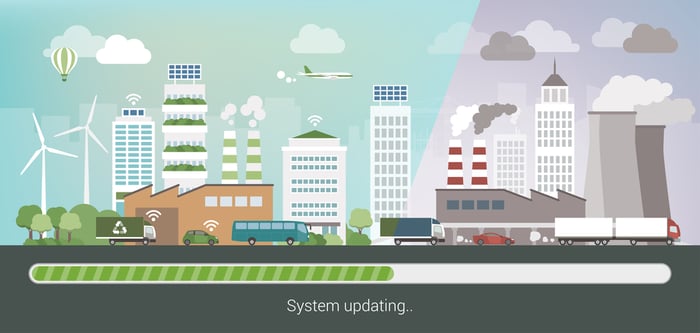With modern building materials and energy-efficient technologies, a new building can be designed to be highly efficient. However, a complete demolition and reconstruction of existing buildings has zero feasibility from a financial point of view and the resulting waste offsets a large part of the environmental benefits. For this reason, building rehabilitation is very important to make population centers greener and more sustainable.
The difficulty of a retrofit varies depending on the characteristics of the building being updated. For example, an LED lighting upgrade is a much simpler project than a plumbing upgrade. Light fixtures can be updated with minimal disruption, while plumbing modifications often require partial demolition since components are embedded in the walls and floor. A professional energy audit is recommended to identify the most promising upgrades for your building.
Identify the best energy efficiency measures for your building.
Building renovations can be expensive, but the investment remains small compared to new construction. There are several complementary approaches that can drive construction improvements:
- Public disclosure, so that building owners are informed about the benefits of renovations.
- Incentive programs, which improve the business case for specific building improvements.
- Updates to legislation and building code, establishing a minimum performance baseline.
In theory, local governments can introduce strict energy efficiency standards and make them mandatory for the entire building sector. However, this approach is unfeasible due to the financial burden on building owners. A smarter approach is to gradually introduce performance standards and promote a higher level of efficiency through education and incentives.
Promoting building renovations through public outreach
Energy efficiency and renewable generation have become mainstream concepts, but there is still a misconception that they cause financial losses. In most projects, energy efficiency and renewables offer a favorable business case, achieving a payback period that is only a fraction of their useful life.
LED lighting provides a clear example of the savings potential. An LED bulb is more expensive than an incandescent bulb, but the comparison is not fair because the LED bulb lasts 20 times longer.
- When the cost of 20 incandescent bulbs is considered, LED is the winner.
- Also consider that energy savings of over 80% are typical when upgrading from incandescent lighting to LED.
- The best LED manufacturers typically offer five-year warranties, while the payback period is usually less than three years. With a payback period shorter than the warranty period, LED lighting is a very safe investment.
Common misconceptions often get in the way of building renovations. Many technologies that were expensive and unreliable several years ago are now covered by standards and much more affordable. For this reason, public awareness can be a very powerful tool for making buildings greener. The Urban Green Council is a trusted green building organization that conducts outreach activities in New York.
Incentive programs for building retrofits
Governments and utility companies often use incentive programs to improve financial returns from building renovations. The 30% federal tax credit is a clear example of this and has been a key factor driving investment in solar energy across the US.
- According to the Solar Energy Industries Association, installed solar power capacity in the U.S. has increased 8,600% since the tax credit was introduced in 2006.
- Photovoltaic systems are now viable without this tax credit, but their cost was about five times higher when the benefit was introduced.
Incentives for building improvements also include cash rebates and tax exemptions. Cash rebates are paid upfront to building owners when they implement eligible technologies, reducing their net cost. Tax breaks also make building renovations easier to pay for, reducing ownership costs.
Making building upgrades mandatory with legislation
Governments can address critical deficiencies in the construction sector by introducing mandatory updates. However, this approach should be used with caution as it may cause financial burdens for some sectors. In particular, the affordable housing sector is susceptible to mandatory building improvements as regulated rental rates leave limited funds to invest in property.

When legislation is used to drive retrofits, the laws must be analyzed carefully or they may threaten the financial viability of some buildings. Ideally, any such bill would include exceptions for construction sectors with limited access to financing, such as affordable housing.
Mandatory building improvements have a reduced impact when they are required with a long time frame and gradual performance targets. Requiring a large efficiency improvement in a short space of time will likely result in many building owners failing to comply, even if they are fully willing to comply with the requirements.
Conclusion
Retrofits can significantly reduce the building sector's energy footprint, but are unlikely to happen on their own. Public awareness and ongoing education can drive improvements in buildings, making owners aware of the benefits provided by new technologies. Incentive programs can be useful for emerging technologies, and legislation can address important deficiencies in the construction sector with mandatory updates.
Because each property is unique and some technologies are still emerging, a combination of the three approaches produces a better result than focusing on one of them.

